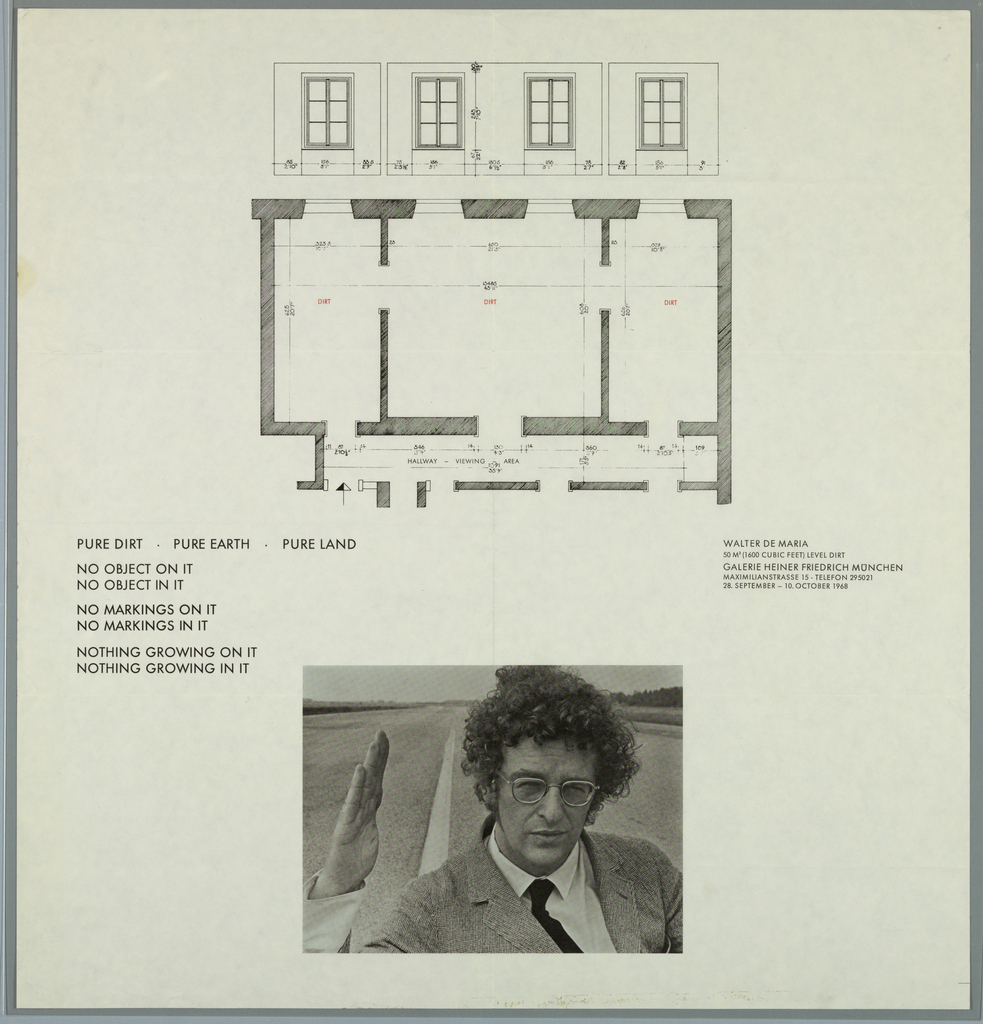“THE DIRT (OR EARTH) IS THERE NOT ONLY TO BE SEEN BUT TO BE THOUGHT ABOUT!” Walter de Maria stated in the press release for the first installation of his influential Earth Room at the Galerie Heiner Friedrich Gallery in Munich, Germany in 1968. The show, titled “Walter de Maria The Land Show: Pure Dirt Pure Earth Pure Land,” exemplified the unique, organic aesthetic that would characterize his career and the broader Land Art Movement. The installation consisted of fifty cubic meters of dirt spread sixty centimeters deep across three adjoining rooms of the gallery. Viewers were not permitted to walk through the space or touch the dirt, but were given three viewing points to examine the installation. [1] By restricting viewers’ movement, de Maria transformed the gallery walls into a physical frame, compelling visitors to view the work like a painting. The organic material thus became both the medium and subject matter. De Maria reconsidered the gallery as a contained space, where the complex relationship between nature and artifice was highlighted. The influential British land artist, Peter Hutchinson, wrote about the installation in the 1968 issue of Arts Magazine, “Walter de Maria’s title ‘Pure Dirt’ plays on the difference between the words ‘dirt’ and ‘earth.’ Like the concrete poets, de Maria prefers to show the actual thing rather than the interpretation.”[2]
The poster in the Cooper Hewitt’s collection (1999-45-11) is an offset lithograph made by de Maria, that functioned as an announcement for the exhibition at the Galerie Heiner Friedrich. The artist’s choice to print a poster, a medium that is inherently reproducible, seems incongruent with the ephemerality of the installation. Pure Dirt offered differing interpretations of terminology and utilized physical material to challenge preconceived notions. In the accompanying poster, de Maria prints an architect’s rendering of the gallery floor plan and interior elevation, with a lexical representation of the installation. On the right side, de Maria introduces the title, location and duration of the exhibition in compact, simple text. Below the plan is a black and white photographic portrait of Walter de Maria with his right hand raised, in front of an indistinguishable, expansive landscape. Larger black text is printed in capitals on the left side that alludes to de Maria’s intentions for the installation.
Although the words may seem simple and discrete, de Maria successfully emphasizes the purity of the organic materials and asserts the lack of human intervention in the work. The only marks of color in the poster are the three “DIRTS” that are printed in bright red in the floor plan of the gallery. De Maria’s decision to color the representations of the earth amidst the monochromatic text dramatizes the significance of the work’s organic elements. The complex connotations of the installation are duplicated in the poster’s juxtaposition of diverse visual forms: photography, language, and architectural design.
Pure Dirt only lasted several weeks, but the poster now acts as a relic of the installation, a deceptively simple object that reveals the artist’s anomalous engagement with the institutional and aesthetic critiques that became essential objectives of the Land Art Movement.
Lily Gildor is a candidate in the MA History of Design and Curatorial Studies program offered at Parsons The New School of Design jointly with The Cooper Hewitt. She is a Master’s fellow in the Drawings, Prints and Graphic Design department.
[1] Galerie Heiner Friedrich. “Walter De Maria The Land Show: Pure Dirt Pure Earth Pure Land.” Press release. Munich: Galerie Heiner Friedrich, 1968.
[2] Hutchinson, Peter. “Earth in Upheaval, Earth Works and Landscapes.” Arts Magazine 43, 2 (November 1968): 21.
